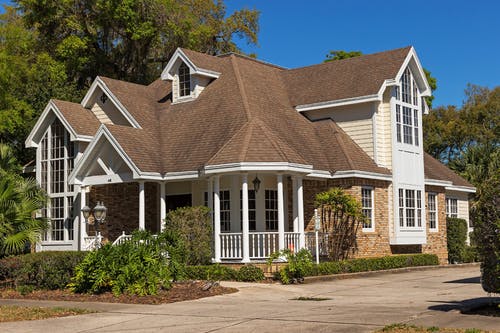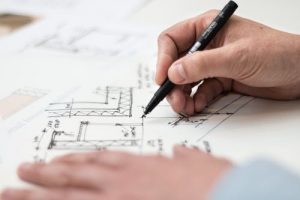Have you heard the saying “In a world full of thorns, be a rose”? It means that in a world full of commonality… stand out! So, we’d like to say “In a world full of commercial steel, be a house”! Don’t just do what everyone else is doing and build your home with wood or concrete. Understand that there is another – and in many ways, a better – option available to frame your residence. Cold-formed steel is not just for commercial use anymore!
Cold-formed steel has taken the construction world by storm and if you’re familiar with the industry at all, you’re likely no stranger to cold-formed steel. With every passing year, this material proves that it’s a force to be reckoned with, especially in commercial construction. Cold-formed steel continues to be the material of choice for owners, developers, engineers, architects, and contractors due to it’s sustainability, flexibility, and high load capabilities. Yet, utilizing cold-formed steel to frame single-family homes is still a concept that is foreign to so many people. So, if you are interested in learning more about the benefits of cold-formed steel in residential construction, we are here to help guide your way and teach you how to be that rose in a world full of thorns…
Cold-Formed Steel Overview
Cold-formed steel studs are made from sheet metal that is rolled to form various sized members. This is a cold process, involving no heat, which is why these studs are called “cold-formed” or also known as “light steel” members. Light steel framing studs typically vary in thickness between 0.0147 in. (0.373 mm) to about 1/8 inch.
To add to all the benefits, cold-formed steel is environmentally friendly while also being resistant to fire, mold, termites, and vermin. And depending on the size and requirements, it’s often more affordable. It is a superior product that is strong and versatile.
Typical Cold-Formed Steel Uses in Mid-rise and Multi-Residential Projects
As we discuss residential uses for cold-formed steel, let’s take note that there are many other common projects where someone usually sees cold-formed steel being used to satisfy framing requirements for the secondary or primary structure.
- Hotels (up to 10 stories)
- Apartment buildings (up to 10 stories)
- Commercial offices
- Business establishments
- Warehouses
When it comes to using cold-formed steel as the primary structure, these projects are typically low to mid-rise buildings that have a repeating floor plan. Currently, the industry standard allows load-bearing metal studs to frame structures up to 10 stories. However, there is argument in the industry that 10 stories is too much for steel studs to handle as the primary structure. This is why it’s critical for licensed Engineers to perform a design assist so they can assist in the understanding of any load-bearing metal framing limitations. Plus, it’s important to remember that the same 10-story limitation does not pertain to light steel framing when it is being used for secondary framing or curtain-wall purposes.
While these particular projects thrive with the use of cold-formed steel framing, there is still much knowledge for the industry to gain in regards to why cold-formed steel is also a good fit for single family residential construction.
Benefits of Cold-Formed Steel in Residential Use
Most homes today are still built with wood, and while wood has proven its practicability through the years, there are just some ways that wood can’t compete with steel. From luxurious homes to small cottages, cold-formed steel is a proven viable construction material option. Framing projects with cold-formed steel studs isn’t a new concept, but using steel studs to build a home is an idea that many professionals are still unfamiliar with. Let’s break down some of the most prominent benefits of using cold-formed steel for residential construction.
Increased Strength & Flexibility
Cold-formed steel provides the perfect amount of flexibility to be used in residential construction while also being rigid enough to get the job done efficiently and safely. Engineers can also easily assess how steel studs might react in various situations, because design professionals have cold-formed steel design software available to them that will design and examine each scenario. Plumbers and electricians love the flexibility offered with steel studs, because there are punch-outs in the members that simplify the act of running wires and pipes. The list goes on… every trade can list positive reasons for why they prefer cold-formed steel framing.
Cold-formed steel will also not crack, deform, split, or crack under duress. Simply put, it will stay put! Additionally, cold-formed steel has a much higher weight threshold than wood. In terms of strength-to-weight, cold-formed steel is 25x stronger.
Bugs Be Gone
While cold-formed steel won’t necessarily keep bugs away, the steel cannot be harmed or destroyed by pests and vermin. Creatures like termites, mites, wasps, and mice can’t chew through cold-formed steel, and this provides your home with increased structural stability.
Fire Safety
Cold-formed steel is a non-combustible material that – unlike wood – won’t feed a fire. This means that the fire safety rating of your home just increased tenfold if you build with steel studs. Increased fire safety also generates decreased homeowner insurance costs, proving that the savings of building with cold-formed steel just keeps adding up!
No Mold
Mold. It’s one word that no homeowner ever wants to hear! Mold means that there’s moisture or water damage, and if a home is built with wood studs then you could have a rotting mess on your hands. Mold not only jeopardizes the health of the occupants, but it can jeopardize the entire structural integrity of a wood framed home. But, since steel is not an organic material, it is impervious to mold growth. No more risk of the wood frame sagging, twisting, or warping.
Sustainability
Cold-formed steel is an eco-friendly construction material. It is fully recyclable, making it highly sustainable. Did you know that it takes 40 trees to build a typical wood framed 2,000 sq ft home, but it only takes FOUR recycled cars to frame the same house with steel studs?! Additionally, cold-formed steel has no VOCs (volatile organic compounds) in its structure. In the current world where sustainability is highly important, cold-formed steel delivers.
Conclusion
Whether you’re renovating or building your dream home; be sure you understand all options for construction. Wood might be the most common option for residential construction, but it is by far not the only option. Cold-formed steel is an incredible construction material that outshines wood in many areas. If you want a building material that is strong, versatile, sustainable, and resistant to mold, fire, pests and vermin, then cold-formed steel is sure to make all your homeowner dreams come true!



Recent Comments